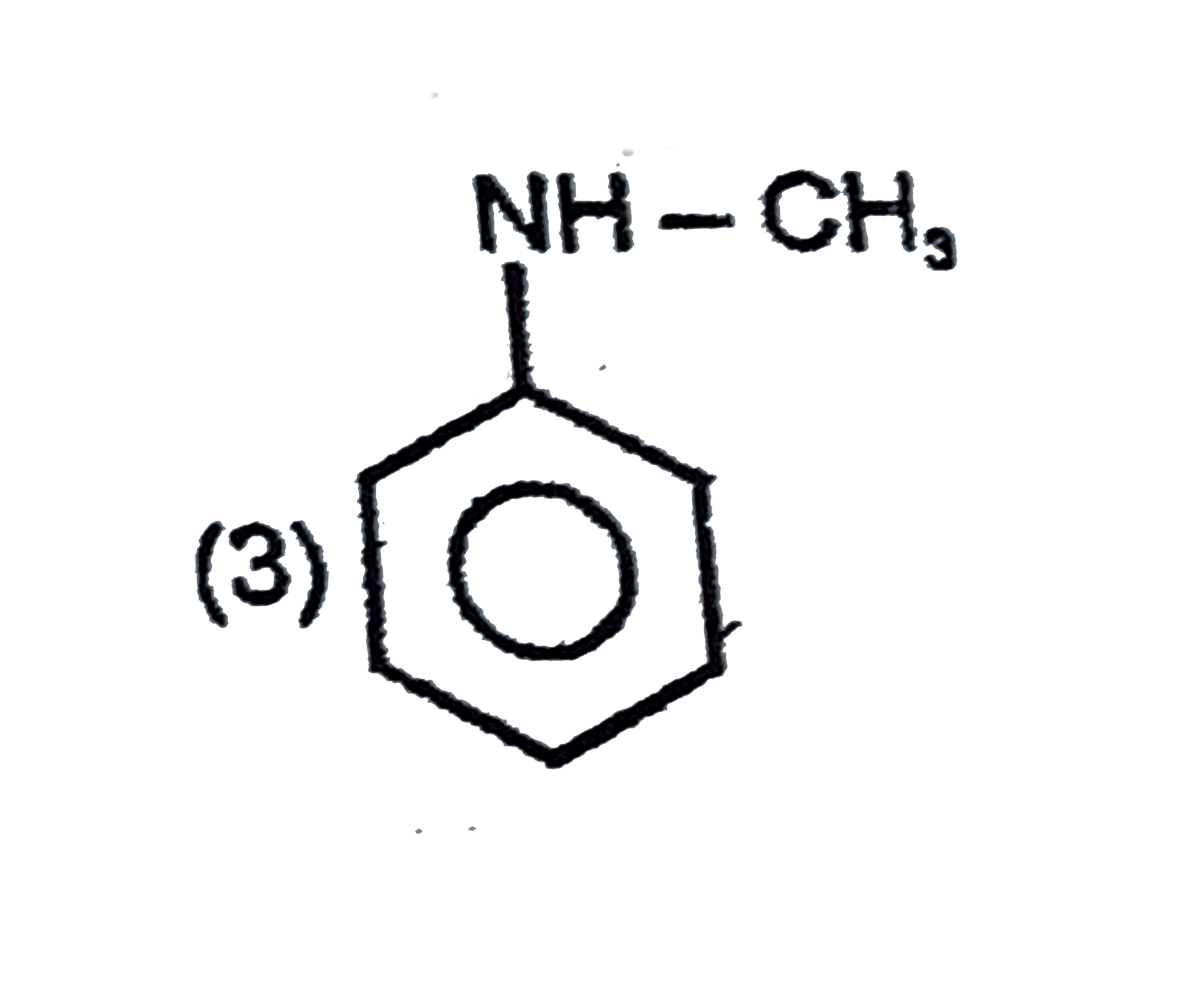Compound (x)(m.f=C7H8N), on reaction with NaNO2 and conc. HCl at O∘C followed by β− naphthol gives orange coloured dye. Compound (x) is :



All of these
The correct Answer is:B
To solve the problem, we need to identify the compound (x) with the molecular formula C7H8N that reacts with NaNO2 and concentrated HCl at 0∘C to form an orange-colored azo dye when followed by β-naphthol.
1. Understanding the Reaction: The reaction described involves an aromatic primary amine. This type of amine can react with sodium nitrite (NaNO2) and hydrochloric acid (HCl) to form a diazonium salt, which can then couple with β-naphthol to produce an azo dye.
2. Identifying the Structure of Compound (x): The molecular formula C7H8N suggests that the compound is an aromatic primary amine. The simplest aromatic amine is aniline (C6H5NH2), which has a phenyl group attached to an amine group. To meet the molecular formula C7H8N, we can add a methyl group (CH3) to the aniline structure.
3. Possible Structures: The methyl group can be attached to the benzene ring in three possible positions relative to the amine group:
- Ortho position: C6H4(NH2)(CH3) (1,2-dimethylamine)
- Meta position: C6H4(NH2)(CH3) (1,3-dimethylamine)
- Para position: C6H4(NH2)(CH3) (1,4-dimethylamine)
4. Reactivity with NaNO2 and HCl: All three structures are aromatic primary amines and will react with NaNO2 and HCl to form the corresponding diazonium salts.
5. Coupling with β-Naphthol: The diazonium salt formed will then couple with β-naphthol to form an azo dye. The resulting azo dye will have an orange color, which is characteristic of azo compounds formed from such reactions.
6. Conclusion: Since all three structures can potentially lead to the formation of an azo dye, we need to identify which one is the correct compound (x) based on the options provided.
- After analyzing the options, we find that Option 2 corresponds to one of the possible structures of (x) that fits the criteria given in the question.
Final Answer:
The compound (x) is Option 2.
- Ortho position: C6H4(NH2)(CH3) (1,2-dimethylamine)
- Meta position: C6H4(NH2)(CH3) (1,3-dimethylamine)
- Para position: C6H4(NH2)(CH3) (1,4-dimethylamine)
The compound (x) is Option 2.
Topper's Solved these Questions
- NITROGEN CONTAINING COMPOUNDSBOOK - RESONANCE ENGLISHCHAPTER - NITROGEN CONTAINING COMPOUNDSEXERCISE - ORGANIC CHEMISTRY(Nitrogen containing Compounds)
30 Videos
- NITROGEN & OXYGEN FAMILYBOOK - RESONANCE ENGLISHCHAPTER - NITROGEN & OXYGEN FAMILYEXERCISE - Part-III Practice Test-2 (JEE (Advanced Pattern))
23 Videos
- NUCLEAR CHEMISTRYBOOK - RESONANCE ENGLISHCHAPTER - NUCLEAR CHEMISTRYEXERCISE - STAGE-II
1 Videos
Similar Questions
Statement I: Aniline on reaction with NaNO2HCl at 0∘C followed by coupling with β-naphthol gives a dark blue coloured precipitate.
Statement II: The colour of the compound formed in the reaction of aniline with NaNO2/HCl at 0∘C followed by coupling with β-naphthol is due to extended conjugation.
View SolutionHow many toluidines on reaction with NaNO2/HCl followed by H3PO2 treatment gives Toluene.
View SolutionA hydrocarbon 'A' (C4H8) on reaction HCl gives a compound 'B', (C4H9Cl) which on reaction with 1 mol of NH3 gives compounds 'C' (C4H11N). On reacting with NaNO2 and HCl followed by treatment with water compound 'C' yields an optically active alcohol, 'D'. Ozonolysis of 'A' given 2mols of acetyldehyde. Identify compound 'A' to 'D'. Explain the reaction involved.
View SolutionAn alkene (A)C16H16 on ozonolysis gives only one product (B)(C8H8O). Compound (B) on reaction with NH2OH followed by reaction with H2SO4,Δ gives N - methyl benzamide the compound 'A' is -
View SolutionAn organic compound A’ with molecular formula C7H7NO reacts with Br2/aqKOH to give compound B’, which upon reaction with NaNO2&HCl at O∘C gives C’. Compound C’ on heating with CH3CH2OH gives a hydrocarbon D’. Compound B’ on further reaction with Br2 water gives white precipitate of compound E’. Identify the compound A, B, C, D&E, also justify your answer by giving relevant chemical equations.
View SolutionA hydrocarbon 'A' (C4H8) on reaction HCl gives a compound 'B', (C4H9Cl) which on reaction with 1 mol of NH3 gives compounds 'C' (C4H11N). On reacting with NaNO2 and HCl followed by treatment with water compound 'C' yields an optically active alcohol, 'D'. Ozonolysis of 'A' given 2mols of acetyldehyde. Identify compound 'A' to 'D'. Explain the reaction involved.
View SolutionA hydrocarbon 'A' (C4H8) on reaction HCl gives a compound 'B', (C4H9Cl) which on reaction with 1 mol of NH3 gives compounds 'C' (C4H11N). On reacting with NaNO2 and HCl followed by treatment with water compound 'C' yields an optically active alcohol, 'D'. Ozonolysis of 'A' given 2mols of acetyldehyde. Identify compound 'A' to 'D'. Explain the reaction involved.
View SolutionA hydrocarbon 'A' (C4H8) on reaction HCl gives a compound 'B', (C4H9Cl) which on reaction with 1 mol of NH3 gives compounds 'C' (C4H11N). On reacting with NaNO2 and HCl followed by treatment with water compound 'C' yields an optically active alcohol, 'D'. Ozonolysis of 'A' given 2mols of acetyldehyde. Identify compound 'A' to 'D'. Explain the reaction involved.
View SolutionWhich of the following compounds reacts with NaNO2 and HCl at 0-4∘C to give alcohol/phenol?
View SolutionCompound (A) (C8H8O) on treatment with NH2OH.HCl gives (B) and (C ). (B) and (C ) rearrange to give (D) and E, respectively, on treatment with acid. (B), (C ), (D), and (E ) are all isomers of molecular formula (C8H9NO). When (D) is boiled with alcoholic KOH, an oil (F) (C6H7N) separates out. (F) reacts rapidly with CH3COCl to give back (D). On the other hand, (E ) on boiling with alkali followed by acidification gives a white solid (G) (C7H6O2). Identify (A) to (G).
View Solution
